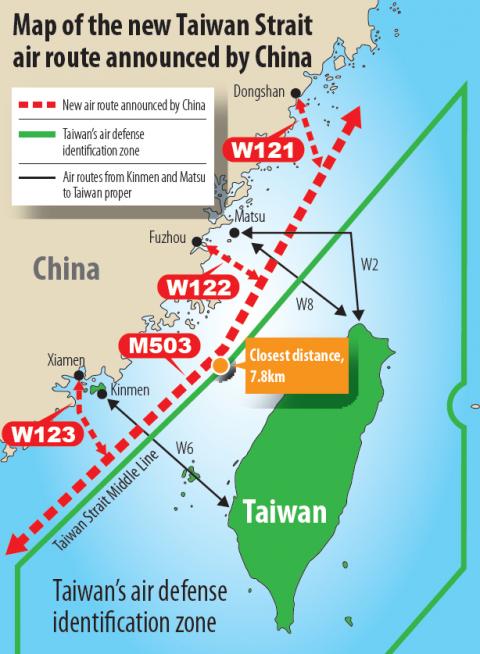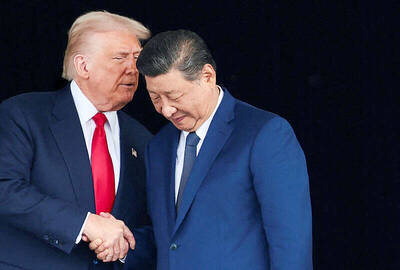Taiwan will closely monitor Chinese flights that are scheduled to start using a contentious new flight route on Thursday next week and may ask for military assistance to warn off planes entering Taipei’s flight information region (FIR), Deputy Minister of Transportation and Communications Tseng Dar-jen (曾大仁) said yesterday.
Beijing last month unilaterally declared four new flight routes — the M503 route, as well as three feeder routes — W121, W122 and W123 — which it said would be implemented from midnight on Thursday.
Taiwan’s Civil Aeronautics Administration (CAA) said earlier this week that Chinese airlines could not begin using the routes until a consensus is reached between the two nations. However, it did not say how it would stop Chinese flights from using these routes.

Tseng said that China had followed International Civil Aviation Organization regulations when it established the routes, which have also been recognized by the organization.
However, “we found the move unacceptable and protested against it because China did not notify and communicate with neighboring FIRs before it announced the establishment of the new routes, as is customary in the international community,” Tseng said.
“We will watch closely whether China actually uses the M503 route. If that happens, we will warn any flights not to enter the Taipei FIR without prior notification and might ask for the military to send planes to chase them off,” he said. “As far as I know, China will not begin using the feeder routes at this stage.”
According to the CAA, the M503 is a north-south route that falls within the Shanghai FIR and comes as close as 7.8km to the median line of the Taiwan Strait. China says it was necessary to ease severe congestion of international flights along its southeast coast.
Among the three east-west feeder routes, W122 could affect Taiwanese air routes W8 and W2, which are used by flights between Taiwan proper and the outlying island of Matsu. The W123 route is close to Taiwan’s route W6, which is used by flights to Kinmen.
Despite protests from Taiwan, it is still likely that China will begin allowing flights on the M503 route, Tseng said, adding that the government would continue communicating with Beijing on the issue of aviation safety if the new routes are implemented.
CAA air traffic control department director Lee Jian-kuo (李建國) said that the two sides are still negotiating over safety issues.
The safety issue with the M503 route is less complicated than the three feeder routes, he said.
China has indicated that flights would operate along a buffer zone that is about 7.4km west of M503 when the route goes into service, he said. It has also required that Chinese fights on M503 must not fly below 27,000 feet (8,229.6m).
Lee said Taiwanese flights close to M503 would keep their altitude below 24,000 feet, adding that altitude can be used as a way to separate Chinese and Taiwanese flights.
Nonetheless, Lee said, the government wants China to move further west from the middle line of the Taiwan Strait so that both sides would have sufficient time to react in emergency situations.
Safety is a bigger concern for the feeder routes, as they will put Taiwanese flights landing in Kinmen or Matsu close to flights departing from China, he said.
“We hope both sides talk about the safety of these routes one at a time,” he said.

The Central Weather Administration (CWA) yesterday said it expected to issue a sea warning for Typhoon Fung-Wong tomorrow, which it said would possibly make landfall near central Taiwan. As of 2am yesterday, Fung-Wong was about 1,760km southeast of Oluanpi (鵝鑾鼻), Taiwan’s southernmost point, moving west-northwest at 26kph. It is forecast to reach Luzon in the northern Philippines by tomorrow, the CWA said. After entering the South China Sea, Typhoon Fung-Wong is likely to turn northward toward Taiwan, CWA forecaster Chang Chun-yao (張峻堯) said, adding that it would likely make landfall near central Taiwan. The CWA expects to issue a land

Taiwan’s exports soared to an all-time high of US$61.8 billion last month, surging 49.7 percent from a year earlier, as the global frenzy for artificial intelligence (AI) applications and new consumer electronics powered shipments of high-tech goods, the Ministry of Finance said yesterday. It was the first time exports had exceeded the US$60 billion mark, fueled by the global boom in AI development that has significantly boosted Taiwanese companies across the international supply chain, Department of Statistics Director-General Beatrice Tsai (蔡美娜) told a media briefing. “There is a consensus among major AI players that the upcycle is still in its early stage,”

The Central Weather Administration (CWA) yesterday said it is expected to issue a sea warning for Typhoon Fung-wong this afternoon and a land warning tomorrow. As of 1pm, the storm was about 1,070km southeast of Oluanpi (鵝鑾鼻), Taiwan’s southernmost point, and was moving west-northwest at 28 to 32kph, according to CWA data. The storm had a radius of 250km, with maximum sustained winds of 173kph and gusts reaching 209kph, the CWA added. The storm is forecast to pass near Luzon in the Philippines before entering the South China Sea and potentially turning northward toward Taiwan, the CWA said. CWA forecaster Chang Chun-yao (張峻堯) said

‘SECRETS’: While saying China would not attack during his presidency, Donald Trump declined to say how Washington would respond if Beijing were to take military action US President Donald Trump said that China would not take military action against Taiwan while he is president, as the Chinese leaders “know the consequences.” Trump made the statement during an interview on CBS’ 60 Minutes program that aired on Sunday, a few days after his meeting with Chinese President Xi Jinping (習近平) in South Korea. “He [Xi] has openly said, and his people have openly said at meetings, ‘we would never do anything while President Trump is president,’ because they know the consequences,” Trump said in the interview. However, he repeatedly declined to say exactly how Washington would respond in